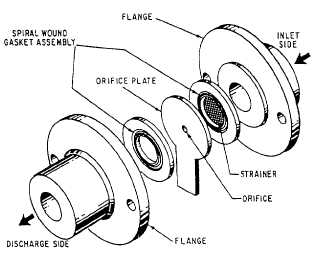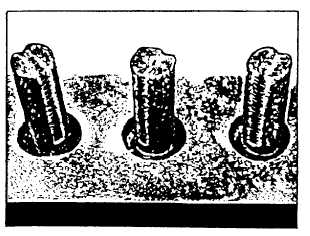condensate from main steam lines, auxiliary steam
lines, and other steam components. The main
working parts of this steam trap are a segmented
bimetallic element and a ball-type check valve.
The bimetallic element has several bimetallic
strips fastened together in a segmented fashion,
as shown in figure 9-36. One end of the bimetallic
element is fastened rigidly to a part of the valve
body; the other end, which is free to move, is
fastened to the top of the stem of the ball-type
check valve.
Line pressure acting on the check valve keeps
the valve open. When steam enters the trap body,
the bimetallic element expands unequally because
of the different response to the temperature of
the two metals; the bimetallic element deflects
upward at its free end, thus moving the valve stem
upward and closing the valve. As the steam cools
and condenses, the bimetallic element moves
downward, toward the horizontal position, thus
opening the valve and allowing some condensate
to flow out through the valve. As the flow of
condensate begins, an unbalance of line pressure
across the valve is created; since the line pressure
is greater on the upper side of the ball of the check
valve, the valve now opens wide and allows a full
capacity flow of condensate.
Orifice Steam Traps
Aboard ship, continuous-flow steam traps of
the orifice type are used in systems or services in
which condensate forms at a fairly steady rate.
Figure 9-37 shows one orifice-type steam trap.
Several variations of the orifice-type steam
trap exist, but all have one thing in common—
they have no moving parts. One or more restricted
passageways or orifices allow condensate to trickle
through but do not allow steam to flow through.
Besides orifices, some orifice-type steam traps
have baffles.
MAINTENANCE
A strainer is installed just ahead of each steam
trap. The strainer must be kept clean and in good
condition to keep scale and other foreign matter
from getting into the trap. Scale and sediment
can clog the working parts of a steam trap and
seriously interfere with the working of the trap.
Steam traps that are not operating properly
can cause problems in systems and machinery.
One way to check on the operation of a steam trap
is to listen to it. If the trap is leaking, you will
probably be able to hear it blowing through.
Another way to check the operation of steam traps
is to check the pressure in the drain system. A
leaking steam trap causes an unusual increase in
pressure in the drain system. When observing this
condition, you can locate the defective trap by
cutting out (isolating from the system) traps, one
at a time, until the pressure in the drain system
returns to normal.
You should disassemble, clean, and inspect
defective steam traps. After determining the cause
of the trouble, repair or replace parts as required.
In some steam traps, you can replace the main
working parts as a unit; in others, you may
have to grind in a seating surface, replace a
disk, or perform other repairs. You should reseat
defective trap discharge valves. Always install new
gaskets when reassembling steam traps.
FILTERS AND STRAINERS
Fluids are kept clean in a system principally
by devices such as filters and strainers. Magnetic
Figure 9-37.—Constant-flow drain orifice.
9-26
Figure 9-38.—Magnetic plugs.




